term of art which does not track its everyday, dictionary meaning. What constitutes an "idea" in the lexicon of copyright law cannot be determined by empirically analyzing a given fact situation until the nascent dividing line between the "idea" and its "expression" finally crystallizes; indeed, just the reverse is true. Case law reveals that identification of the "idea" in a work is not the starting point but the result of a judicial exercise that in turn is highly dependent on the precise factual situation being tested.[1]Therefore, designation of the enacted code as an idea vel non is a legal conclusion to be reached by a court, not an initial factual finding to be gleaned intuitively. That determination of idea is not antecedent to a policy determination regarding the "copyrightability" of the code; to the contrary, it is the logical
- ↑ Id. ("A court's decision whether to apply the merger doctrine often depends on how it defines the author's idea. For this reason, in defining the idea the courts should be guided by 'the balance between competition and protection reflected in the patent and copyright laws.'")(citations omitted); Peter Pan Fabrics, Inc. v. Martin Wiener Corp., 274 F.2d 487, 489 (2d Cir. 1960) (L. Hand, J.)(discussing what the court termed as "verbal works," the court stated "[T]here can be no copyright in the 'ideas' disclosed but only in their 'expression.' Obviously, no principle can be stated as to when an imitator has gone beyond copying the 'idea,' and has borrowed its 'expression.' Decisions must therefore inevitably be ad hoc."); see also Nimmer on Copyright § 13.03[B][2][a] at 13-60 ("Merely stating the rule [17 U.S.C.? 102(b)], however, does not make any easier the task of drawing the line between where the idea ends and expression begins.").
62
